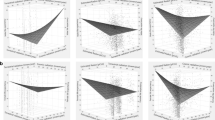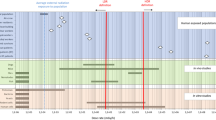Abstract
The current linear no-threshold paradigm assumes that any exposure to ionizing radiation carries some risk, thus every effort should be made to maintain the exposures as low as possible. We examined whether background radiation impacts human longevity and cancer mortality. Our data covered the entire US population of the 3139 US counties, encompassing over 320 million people. This is the first large-scale study which takes into account the two major sources of background radiation (terrestrial radiation and cosmic radiation), covering the entire US population. Here, we show that life expectancy, the most integrative index of population health, was approximately 2.5 years longer in people living in areas with a relatively high vs. low background radiation. (≥ 180 mrem/year and ≤ 100 mrem/year, respectively; p < 0.005; 95% confidence interval [CI]). This radiation-induced lifespan extension could to a great extent be associated with the decrease in cancer mortality rate observed for several common cancers (lung, pancreas and colon cancers for both genders, and brain and bladder cancers for males only; p < 0.05; 95% CI). Exposure to a high background radiation displays clear beneficial health effects in humans. These hormetic effects provide clear indications for re-considering the linear no-threshold paradigm, at least within the natural range of low-dose radiation.


Similar content being viewed by others
Abbreviations
- LNT:
-
Linear no-threshold
- NCRP:
-
National Council on Radiation Protection and Measurements
- EPA:
-
United States Environmental Protection Agency
- USGS:
-
United States Geological Survey
- USCS:
-
United States Cancer Statistics
- CDC:
-
Centers for Disease Control and Prevention
- CI:
-
Confidence interval
- NCI:
-
National Cancer Institute
- IHME:
-
Institute for Health Metrics and Evaluation
- LLR:
-
Low-level radiation
- HLR:
-
High-level radiation
- ICRP:
-
International Commission on Radiological Protection
References
Burtt JJ, Thompson PA, Lafrenie RM (2016) Non-targeted effects and radiation-induced carcinogenesis: a review. J Radiol Prot 36:R23–R35. doi:https://doi.org/10.1088/0952-4746/36/1/R23
Calabrese EJ (2012) Muller’s Nobel Prize Lecture: when ideology prevailed over science. Toxicol Sci 126:1–4. doi:https://doi.org/10.1093/toxsci/kfr338
Calabrese EJ (2016) LNTgate: how scientific misconduct by the U.S. NAS led to governments adopting LNT for cancer risk assessment. Environ Res 148:535–546. doi:https://doi.org/10.1016/j.envres.2016.03.040
Calabrese EJ, Hanekamp JC, Shamoun DY (2018) The EPA cancer risk assessment default model proposal: moving away from the LNT. Dose Response 16:1–4. doi:https://doi.org/10.1177/1559325818789840
Calabrese EJ (2019) The linear no-threshold (LNT) dose response model: a comprehensive assessment of its historical and scientific foundations. Chem Biol Interact 301:6–25. doi:https://doi.org/10.1016/j.cbi.2018.11.020
Cameron JR (2005) Moderate dose rate ionizing radiation increases longevity. Br J Radiol 78:11–13. doi:https://doi.org/10.1259/bjr/62063624
Candéias SM, Testard I (2015) The many interactions between the innate immune system and the response to radiation. Cancer Lett 368:173–178. doi:https://doi.org/10.1016/j.canlet.2015.02.007
Christensen DM, Livingston GK, Sugarman SL, Parillo SJ, Glassman ES (2014) Management of ionizing radiation injuries and illnesses, Part 3: Radiobiology and health effects of ionizing radiation. J Am Osteopath Assoc 114:556–565. doi:https://doi.org/10.7556/jaoa.2014.109
Cohen BL (1995) Test of the linear-no threshold theory of radiation carcinogenesis for inhaled radon decay products. Health Phys 68:157–174. doi:https://doi.org/10.1097/00004032-199502000-00002
Cohen BL (1997) Lung cancer rate vs. mean radon level in U.S. counties of various characteristics. Health Phys 72:114–119. doi:https://doi.org/10.1097/00004032-199701000-00016
Dobrzyński L, Fornalski KW, Feinendegen LE (2015) Cancer mortality among people living in areas with various levels of natural background radiation. Dose Response 13:1–10. doi:https://doi.org/10.1177/1559325815592391
du Prel JB, Hommel G, Röhrig B, Blettner M (2009) Confidence interval or p-value? Part 4 of a series on evaluation of scientific publications. Dtsch Arztebl Int 106:335–339. doi:https://doi.org/10.3238/arztebl.2009.0335
Guéguen Y, Bontemps A, Ebrahimian TG (2019) Adaptive responses to low doses of radiation or chemicals: their cellular and molecular mechanisms. Cell Mol Life Sci 76:1255–1273. doi:https://doi.org/10.1007/s00018-018-2987-5
Hackshaw A, Kirkwood A (2011) Interpreting and reporting clinical trials with results of borderline significance. BMJ 343:d3340. doi:https://doi.org/10.1136/bmj.d3340
Hart J (2010) Cancer mortality in six lowest versus six highest elevation jurisdictions in the U.S. Dose Response 9:50–58. doi:https://doi.org/10.2203/dose-response.09-051.Hart
Hart J (2011) Cancer mortality for a single race in low versus high elevation counties in the U.S. Dose Response 9:348–355. doi:https://doi.org/10.2203/dose-response.10-014.Hart
Hendry JH, Simon SL, Wojcik A, Sohrabi M, Burkart W, Cardis E, Laurier D, Tirmarche M, Hayata I (2009) Human exposure to high natural background radiation: what can it teach us about radiation risks? J Radiol Prot 29:A29–A42. doi:https://doi.org/10.1088/0952-4746/29/2A/S03
ICRP (2007) The 2007 Recommendations of the International Commission on Radiological Protection. ICRP Publication 103. Ann ICRP 37:(2–4)
Kathren RL (2002) Historical development of the linear non-threshold dose-response model as applied to radiation. Pierce L Rev 5:5–30
Kondo S (1993) Health effects of low-level radiation. Kinki University Press, Osaka Medical Physics Publishing, Madison, WI, USA
Lorenz E, Weikel Hollcroft J, Miller E, Congdon CC, Schweisthal R (1955) Long-term effects of acute and chronic irradiation in mice, survival and tumor incidence following chronic irradiation of 0.11 r per day. Natl Cancer Inst 15:1049–1058
Marcus CS (2016) Destroying the linear no-threshold basis for radiation regulation: A commentary. Dose Response 14:1–3. doi:https://doi.org/10.1177/1559325816673491
Muller HJ. Nobel lecture (1946) Available at: https://www.nobelprize.org/prizes/medicine/1946/muller/lecture/
Nambi KS, Soman SD (1987) Environmental radiation and cancer in India. Health Phys 52:653–657. doi:https://doi.org/10.1097/00004032-198705000-00018
NCRP Commentary No. 27 (2018) overview: Implications of recent epidemiologic studies for the linear-non-threshold model and radiation protection. Available at: https://ncrponline.org/product-category/commentaries/
Neel JV, Schull WJ, Awa AA, Samh C, Otake M, Kam H, Yoshimoto Y (1989) Implications of the Hiroshima-Nagasaki genetic studies for the estimation of the human “doubling dose” of radiation. Genome 31:853–859
Puskin JS (2009) Perspective on the use of LNT for radiation protection and risk assessment by the U.S. Environmental Protection Agency. Dose Response 7:284–291. doi:https://doi.org/10.2203/dose-response.09-005.Puskin
Sacks B, Siegel JA (2017) Preserving the anti-scientific linear no-threshold myth: Authority, agnosticism, transparency, and the standard of care. Dose Response 15:1–4. doi:https://doi.org/10.1177/1559325817717839
Sanders CL (2010) Radiation hormesis and the linear-no-threshold assumption. Springer, Heidelberg
Sanders CL (2017) Radiobiology and radiation hormesis. Springer, Heidelberg
Shore RE, Beck HL, Boice JD, Caffrey EA, Davis S, Grogan HA, Mettler FA, Preston RJ, Till JE, Wakeford R, Walsh L, Dauer LT (2018) Implications of recent epidemiologic studies for the linear nonthreshold model and radiation protection. J Radiol Prot 38:1217–1233. doi:https://doi.org/10.1088/1361-6498/aad348
Shore RE, Beck HL, Boice JD Jr, Caffrey EA, Davis S, Grogan HA, Mettler FA Jr, Preston RJ, Till JE, Wakeford R, Walsh L, Dauer LT (2019) Recent epidemiologic studies and the linear no-threshold model for radiation protection-considerations regarding NCRP Commentary 27. Health Phys 116:235–246. doi:https://doi.org/10.1097/HP.0000000000001015
Tang FR, Loganovsky K (2018) Low dose or low dose rate ionizing radiation-induced health effect in the human. J Environ Radioact 192:32–47. doi:https://doi.org/10.1016/j.jenvrad.2018.05.018
Tharmalingam S, Sreetharan S, Brooks AL, Boreham DR (2019) Re-evaluation of the linear no-threshold (LNT) model using new paradigms and modern molecular studies. Chem Biol Interact 301:54–67. doi:https://doi.org/10.1016/j.cbi.2018.11.013
Thompson GA, Smithers J, Boxenbaum H (1990) Biphasic mortality response of chipmunks in the wild to single doses of ionizing radiation: toxicity and longevity hormesis. Drug Metab Rev 22:269–289. doi:https://doi.org/10.3109/03602539009041086
Vaiserman AM (2010) Hormesis, adaptive epigenetic reorganization, and implications for human health and longevity. Dose Response 8:16–21. doi:https://doi.org/10.2203/dose-response.09-014.Vaiserman
Vaiserman A, Koliada A, Zabuga O, Socol Y (2018) Health impacts of low-dose ionizing radiation: Current scientific debates and regulatory issues. Dose Response 16:1–27. doi:https://doi.org/10.1177/1559325818796331
Vaiserman A, Koliada A, Socol Y (2019) Hormesis through low-dose radiation. In: Rattan SIS, Kyriazis M (eds) The science of hormesis in health and longevity. Elsevier Science Publishing Co Inc, Academic Press, San Diego, pp 129–138
Author information
Authors and Affiliations
Corresponding author
Ethics declarations
Conflict of interest
The authors declare that they have no conflict of interest.
Additional information
Publisher's Note
Springer Nature remains neutral with regard to jurisdictional claims in published maps and institutional affiliations.
Electronic supplementary material
Below is the link to the electronic supplementary material.
10522_2020_9909_MOESM1_ESM.tif
Electronic supplementary material 1 A map of background radiation levels in the US counties. The background radiation levels were divided into 3 categories: the levels lower than 100 mrem/year were defined as "Low radiation"; the levels higher than 180 mrem/year were defined as "High radiation", and the levels between 100 mrem/year and 180 mrem/year were defined as "Mid radiation" (TIF 1304 kb)
Rights and permissions
About this article
Cite this article
David, E., Wolfson, M. & Fraifeld, V.E. Background radiation impacts human longevity and cancer mortality: reconsidering the linear no-threshold paradigm. Biogerontology 22, 189–195 (2021). https://doi.org/10.1007/s10522-020-09909-4
Received:
Accepted:
Published:
Issue Date:
DOI: https://doi.org/10.1007/s10522-020-09909-4




